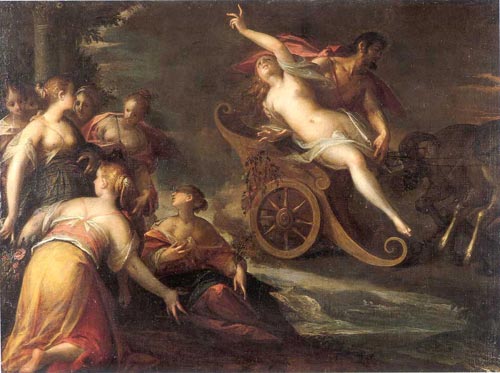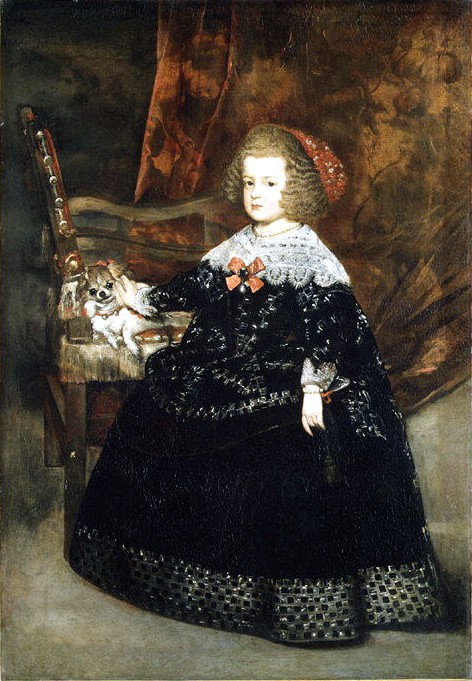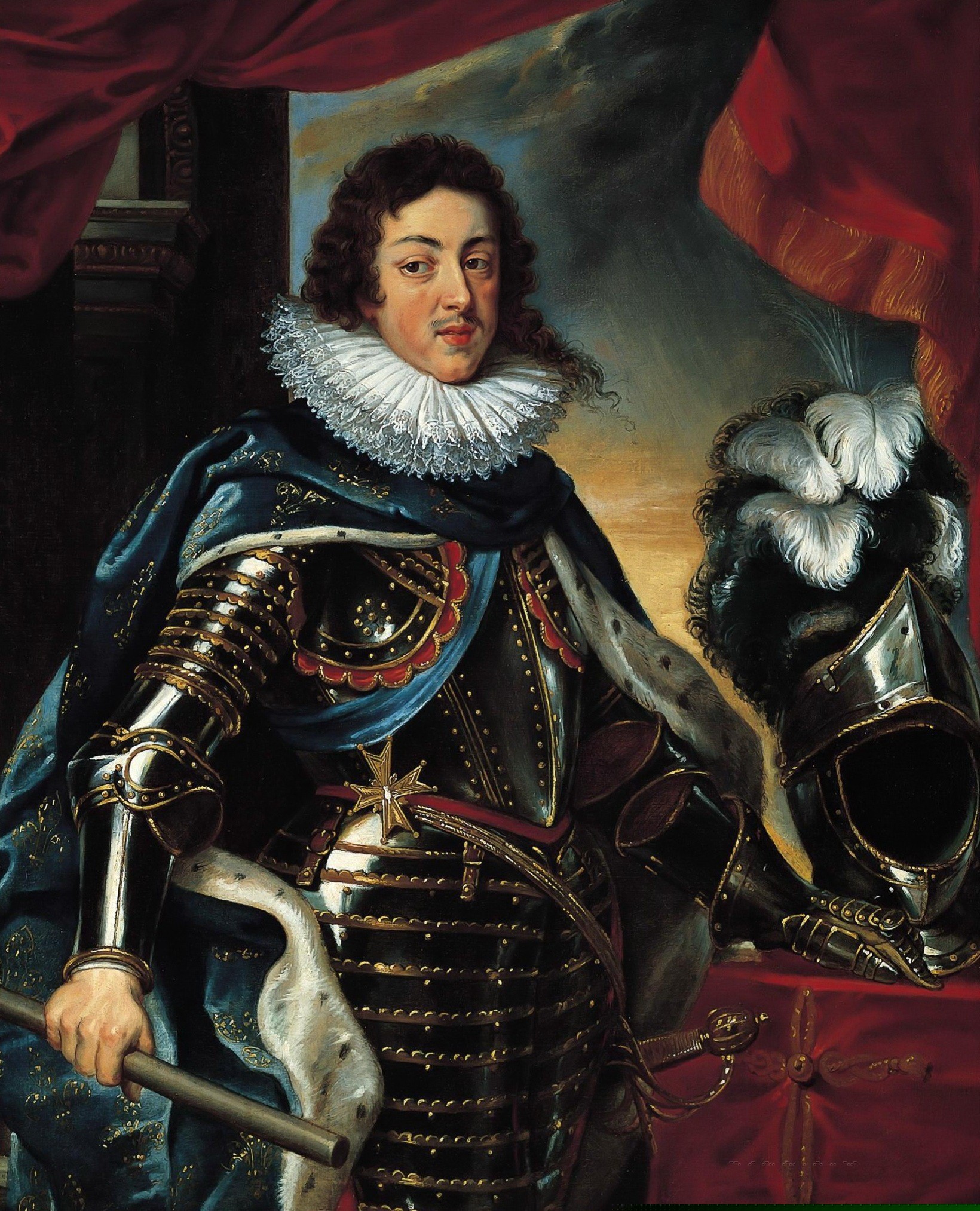|
François Girardon
François Girardon (; 17 March 1628 – 1 September 1715) was a French sculptor of the Louis XIV style or French Baroque, best known for his statues and busts of Louis XIV and for his statuary in the gardens of the Palace of Versailles. Biography He was born at Troyes. His father was a foundry worker. He was first trained as a joiner and woodcarver. His talent attracted the attention of the Chancellor of Louis XIV, Pierre Séguier, a serious patron of the arts, who arranged for him to work in the studio of François Anguier, and later, from 1648 to 1650 to live and apprentice in Rome. There he saw Baroque sculpture and met Bernini, but he came to reject that style and moved instead toward classicism and the models of ancient Roman sculpture. In 1650 he returned to France, and became a member of the group of artists, led by Charles Le Brun, the official painter of the King, and including the garden designer André Le Nôtre, who were commissioned to decorate the new royal pa ... [...More Info...] [...Related Items...] OR: [Wikipedia] [Google] [Baidu] |
Proserpina
Proserpina ( ; ) or Proserpine ( ) is an ancient Roman goddess whose iconography, functions and myths are virtually identical to those of Greek Persephone. Proserpina replaced or was combined with the ancient Roman fertility goddess Libera, whose principal cult was housed in the Aventine temple of the grain-goddess Ceres, along with the wine god Liber. Each of these three deities occupied their own '' cella'' at the temple. Their cults were served or supervised by a male public priesthood. Ceres was by far the senior of the three, one of the '' Dii Consentes'', Rome's approximate equivalent to the Greek Twelve Olympians. She was identified with Greek Demeter and Liber was identified with Bacchus and Dionysus. Libera is sometimes described as a female version of Liber Pater, concerned with female fertility. Otherwise she is given no clear identity or mythology by Roman sources, and no Greek equivalent. Nothing is known of her native iconography: her name translates as a femin ... [...More Info...] [...Related Items...] OR: [Wikipedia] [Google] [Baidu] |
André Le Nôtre
André Le Nôtre (; 12 March 1613 – 15 September 1700), originally rendered as André Le Nostre, was a French landscape architect and the principal gardener of King Louis XIV of France. He was the landscape architect who designed Gardens of Versailles, the gardens of the Palace of Versailles; his work represents the height of the French formal garden style, or ''French formal garden, jardin à la française''. Prior to working on Versailles, Le Nôtre collaborated with Louis Le Vau and Charles Le Brun on the park at Vaux-le-Vicomte. His other works include the design of gardens and parks at Bicton, Devon, Bicton Park Botanical Gardens, Château de Chantilly, Chantilly, Palace of Fontainebleau, Fontainebleau, Château de Saint-Cloud, Saint-Cloud and Château de Saint-Germain-en-Laye, Saint-Germain. His contribution to Urban planning, planning was also significant: at the Tuileries Palace, Tuileries in Paris he extended the westward vista, which later became the Champs-Élys ... [...More Info...] [...Related Items...] OR: [Wikipedia] [Google] [Baidu] |
Maria Theresa Of Spain
Maria Theresa of Spain (; ; 10 September 1638 – 30 July 1683) was Queen consort of France, Queen of France from 1660 to 1683 as the wife of King Louis XIV. She was born an Infante, Infanta of Spain and Portugal as the daughter of King Philip IV of Spain, Philip IV and Elisabeth of France (1602–1644), Elisabeth of France, and was also an Archduke#Usage, Archduchess of Austria as a member of the Spanish branch of the House of Habsburg. Her marriage in 1660 to King Louis XIV, her double first cousin, was arranged with the purpose of ending the lengthy Franco-Spanish War (1635–1659), war between France and Spain. Famed for her virtue and piety, she saw five of her six children die in early childhood, and is frequently viewed as an object of pity in historical accounts of her husband's reign, since she was often neglected by the court and overshadowed by the King's many mistresses. Without any political influence in the French court or government (except briefly in 1672, when sh ... [...More Info...] [...Related Items...] OR: [Wikipedia] [Google] [Baidu] |
Jérôme Bignon
Jérôme Bignon (; 1589–1656) was a French lawyer born in Paris. Life His family originated from the western part of France, and came to Paris at the beginning of the sixteenth century. He was uncommonly precocious, and under his father's tuition had acquired an immense mass of knowledge before he was ten years of age. A work by him entitled ''Choréographie, ou description de la Terre Sainte'' was published in 1600. The great reputation gained by this book served to introduce the author to Henry IV, who placed him for some time as a companion to the duc de Vendôme, and made him tutor to the dauphin, afterwards Louis XIII. In 1604 he wrote his ''Discours de la ville de Rome'', and in the following year his ''Traité sommaire de l' élection du pape''. He then devoted himself to the study of law, and wrote in 1610 a treatise on the precedency of the kings of France, which gave great satisfaction to Henry IV. In 1613, Bignon edited, with learned notes, the '' Formulae of Mar ... [...More Info...] [...Related Items...] OR: [Wikipedia] [Google] [Baidu] |
François-Michel Le Tellier, Marquis De Louvois
François Michel Le Tellier, Marquis de Louvois (; 18 January 1641 – 16 July 1691) was the French Secretary of State for War during a significant part of the reign of Louis XIV. He is commonly referred to as "Louvois". Together with his father, Michel le Tellier, he oversaw an increase in the numbers of the French Army, eventually reaching 340,000 soldiersLynn, J. (1994). Recalculating French Army Growth during the Grand Siecle, 1610-1715. ''French Historical Studies,'' ''18''(4), 881-906. doi:10.2307/286722 – an army that would fight four wars between 1667 and 1713. Louvois was a key military and strategic advisor to Louis XIV, who transformed the French Army into an instrument of royal authority and foreign policy. According to Cathal Nolan, he created the Régiment du Roi in 1663 and founded the Royal-Artillerie regiment in 1673. These innovations influenced military planners beyond France. Louvois sought out new wars as a means of concentrating more power and wealth in ... [...More Info...] [...Related Items...] OR: [Wikipedia] [Google] [Baidu] |
Louvre
The Louvre ( ), or the Louvre Museum ( ), is a national art museum in Paris, France, and one of the most famous museums in the world. It is located on the Rive Droite, Right Bank of the Seine in the city's 1st arrondissement of Paris, 1st arrondissement (district or ward) and home to some of the most Western canon, canonical works of Art of Europe, Western art, including the ''Mona Lisa,'' ''Venus de Milo,'' and ''Winged Victory''. The museum is housed in the Louvre Palace, originally built in the late 12th to 13th century under Philip II of France, Philip II. Remnants of the Medieval Louvre fortress are visible in the basement of the museum. Due to urban expansion, the fortress eventually lost its defensive function, and in 1546 Francis I of France, Francis I converted it into the primary residence of the French kings. The building was redesigned and extended many times to form the present Louvre Palace. In 1682, Louis XIV chose the Palace of Versailles for his househ ... [...More Info...] [...Related Items...] OR: [Wikipedia] [Google] [Baidu] |
Place Vendôme
The Place Vendôme (), earlier known as the Place Louis-le-Grand, and also as the Place Internationale, is a square in the 1st arrondissement of Paris, France, located to the north of the Tuileries Gardens and east of the Église de la Madeleine. It is the starting point of the Rue de la Paix. Its regular architecture by Jules Hardouin-Mansart and pedimented screens canted across the corners give the rectangular Place Vendôme the aspect of an octagon. The original Vendôme Column at the centre of the square was erected by Napoleon I to commemorate the Battle of Austerlitz; it was torn down on 16 May 1871, by decree of the Paris Commune, but subsequently re-erected and remains a prominent feature on the square today. History The Place Vendôme was begun in 1698 as a monument to the glory of the armies of Louis XIV, the Grand Monarque, and called the Place des Conquêtes, to be renamed the Place Louis le Grand, when the conquests proved temporary. An over life-size equestri ... [...More Info...] [...Related Items...] OR: [Wikipedia] [Google] [Baidu] |
Alexandre Lenoir
Marie Alexandre Lenoir (; 27 December 1761 – 11 June 1839) was a French archaeologist. Self-taught, he devoted himself to saving France's historic monuments, sculptures and tombs from the ravages of the French Revolution, notably those of Saint-Denis and Sainte-Geneviève. Life The ravages of the Revolution caused the birth of the Musée des monuments français. Thanks to support from Jean Sylvain Bailly, Alexandre Lenoir successfully demanded that all art objects from state properties be gathered together in this museum. These objects were confiscated at different religious houses and stored in a single place to avoid their dispersal and destruction. Mandated by the National Constituent Assembly in 1791, he brought together the various objects he sought to conserve in the Couvent des Petits Augustins, a building which later was converted to become the École nationale supérieure des Beaux-Arts. On 1 August 1793, the National Convention decreed that the tombs of "forme ... [...More Info...] [...Related Items...] OR: [Wikipedia] [Google] [Baidu] |
Sorbonne (building)
The name Sorbonne (French: ''La Sorbonne''; , ; ) is commonly used to refer to the historic University of Paris in Paris, France or one of its successor institutions (see below). It is also the name of a building in the Latin Quarter of Paris which from 1253 onwards housed the College of Sorbonne, part of one of the first universities in the Western world, later renamed University of Paris and commonly known as "the Sorbonne". The Sorbonne building and the “''La Sorbonne''” trademark are owned by the Chancellerie des Universités de Paris. Today, it continues to house the successor universities of the University of Paris, such as : * Sorbonne University, * Paris 1 Panthéon-Sorbonne University, * Sorbonne Nouvelle University, * and the ''Chancellerie des Universités de Paris'', which manages the building. Sorbonne University is also now the university resulting from the merger on 1 January 2018 of Pierre and Marie Curie University, UPMC (Paris VI) and Paris-Sorbonne U ... [...More Info...] [...Related Items...] OR: [Wikipedia] [Google] [Baidu] |
Cardinal Richelieu
Armand Jean du Plessis, 1st Duke of Richelieu (9 September 1585 – 4 December 1642), commonly known as Cardinal Richelieu, was a Catholic Church in France, French Catholic prelate and statesman who had an outsized influence in civil and religious affairs. He became known as the Red Eminence (), a term derived from the style of Eminence (style), Eminence applied to Cardinal (Catholic Church), cardinals and their customary red robes. Consecrated a bishop in 1607, Richelieu was appointed Secretary of State for Foreign Affairs (France), Foreign Secretary in 1616. He continued to rise through the hierarchy of both the Catholic Church and the French government, becoming a Cardinal (Catholic Church), cardinal in 1622 and Chief minister of France, chief minister to King Louis XIII, Louis XIII of France in 1624. He retained that office until his death in 1642, when he was succeeded by Cardinal Cardinal Mazarin, Jules Mazarin, whose career the cardinal had fostered. Richelieu became enga ... [...More Info...] [...Related Items...] OR: [Wikipedia] [Google] [Baidu] |
Académie Royale De Peinture Et De Sculpture
The Académie royale de peinture et de sculpture (; ) was founded in 1648 in Paris, France. It was the premier art institution of France during the latter part of the Ancien Régime until it was abolished in 1793 during the French Revolution. It included most of the important painters and sculptors, maintained almost total control of teaching and exhibitions, and afforded its members preference in royal commissions. Founding In the 1640s, France's artistic life was still based on the medieval system of guilds like the Académie de Saint-Luc which had a tight grip on the professional lives of artists and artisans alike. Some artists had managed to get exemptions but these were based on favoritism rather than merit. According to the 17th century ''Mémoires'' about the founding of the ''Académie royale'', a few "superior men" who were "real artists", suffered and felt humiliated under the guild system. In view of increasing pressure by the Parisian guilds for painters and s ... [...More Info...] [...Related Items...] OR: [Wikipedia] [Google] [Baidu] |




